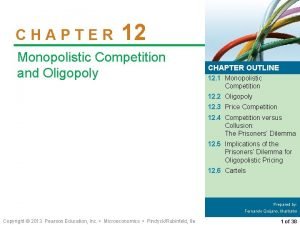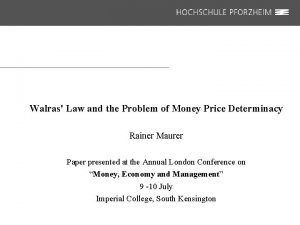Microeconomics in Modules and Economics in Modules Third
















- Slides: 16

Microeconomics in Modules and Economics in Modules Third Edition Krugman/Wells Module 31 Oligopoly

What You Will Learn 1 Why oligopolists have an incentive to act in ways that reduce their combined profit 2 Why oligopolies can benefit from collusion 2 of 13

Understanding Oligopoly • An oligopoly consisting of only two firms is a duopoly. Each firm is a duopolist. • With only two firms in the industry, each realizes that by producing more, it would drive down the market price. 3 of 13

Understanding Oligopoly • So each firm, like a monopolist, realizes that profits will be higher if it limits production. 4 of 13

Understanding Oligopoly • Sellers engage in collusion when they cooperate to raise each other’s profits. • The strongest form of collusion is a cartel, an agreement by several producers to obey output restrictions in order to increase their joint profits. 5 of 13

Understanding Oligopoly • They may also engage in noncooperative behavior, ignoring the effects of their actions on each other’s profits. 6 of 13

Understanding Oligopoly • By acting as if they were a single monopolist, oligopolists can maximize their combined profits. So there is an incentive to form a cartel. • However, each firm has an incentive to cheat— to produce more than it is supposed to under the cartel agreement. 7 of 13

Collusion and Competition • Suppose the presidents of the two lysineproducing firms agree that each will produce 30 million pounds of lysine over the next year in order to maximize their combined profits. 8 of 13

Collusion and Competition • There is an incentive to cheat: – If one firm honors the agreement but the other cheats by increasing output, the price per pound will decrease. – Total industry revenue will decline, but the cheating firm’s profits will increase. – But both firms’ presidents can make the same calculation, and if both firms increase production, each firm’s profits will fall. 9 of 13

Understanding Oligopoly 10 of 13

Collusion and Competition • When firms ignore the effects of their actions on each others’ profits, they engage in noncooperative behavior. • It is likely to be easier to achieve informal collusion when firms in an industry face capacity constraints. 11 of 13

Competing in Prices versus Competing in Quantities • Firms may decide to engage in quantity or price competition. • The basic insight of the quantity competition (or the Cournot model) is that when firms are restricted in how much they can produce, it is easier for them to avoid excessive competition and to divvy up the market. 12 of 13

Competing in Prices versus Competing in Quantities • They thereby price above marginal cost and earn profits. • It is easier for them to achieve an outcome that looks like collusion without a formal agreement. 13 of 13

Economics in Action Bitter Chocolate? • Regulators in Germany, Canada, and the United States are investigating whether the seven leading chocolate companies—including Nestle, Mars, Kraft Foods, Hershey, and Cadbury—have been colluding to raise the prices of chocolate. • In 2010, Supervalu, a snack retailer, filed a lawsuit against Mars, Hershey, Nestle, and Cadbury, who together control about 76% of the U. S. chocolate market, claiming that the confectioners had been fixing prices since 2002. • Evidence of price collusion did emerge when 13 Cadbury executives voluntarily provided information about contact between companies. 14 of 13

Summary 1. Many industries are oligopolies: there are only a few sellers. In particular, a duopoly has only two sellers. 2. Oligopolies exist for more or less the same reasons that monopolies exist, but in weaker form. They are characterized by imperfect competition: firms compete but possess market power. 15 of 13

Summary 3. The firms in an oligopoly could maximize their combined profits by acting as a cartel, setting output levels for each firm as if they were a single monopolist; to the extent that firms manage to do this, they engage in collusion. 4. But each individual firm has an incentive to produce more than it would in such an arrangement—to engage in noncooperative behavior. 16 of 13
 Economics modules
Economics modules Gj mount classification of dental caries
Gj mount classification of dental caries Gj mount classification of dental caries
Gj mount classification of dental caries School of business and economics maastricht
School of business and economics maastricht Principle of economics oxford
Principle of economics oxford Pure public good
Pure public good Microeconomic
Microeconomic What is macroeconomics
What is macroeconomics Mathematical economics vs non mathematical economics
Mathematical economics vs non mathematical economics Copy
Copy What is the subject matter of microeconomics
What is the subject matter of microeconomics Importance of microeconomics
Importance of microeconomics Intermediate microeconomics lecture notes
Intermediate microeconomics lecture notes Intermediate microeconomics notes
Intermediate microeconomics notes Cartel microeconomics
Cartel microeconomics Roger guesnerie
Roger guesnerie The firm basics
The firm basics






























